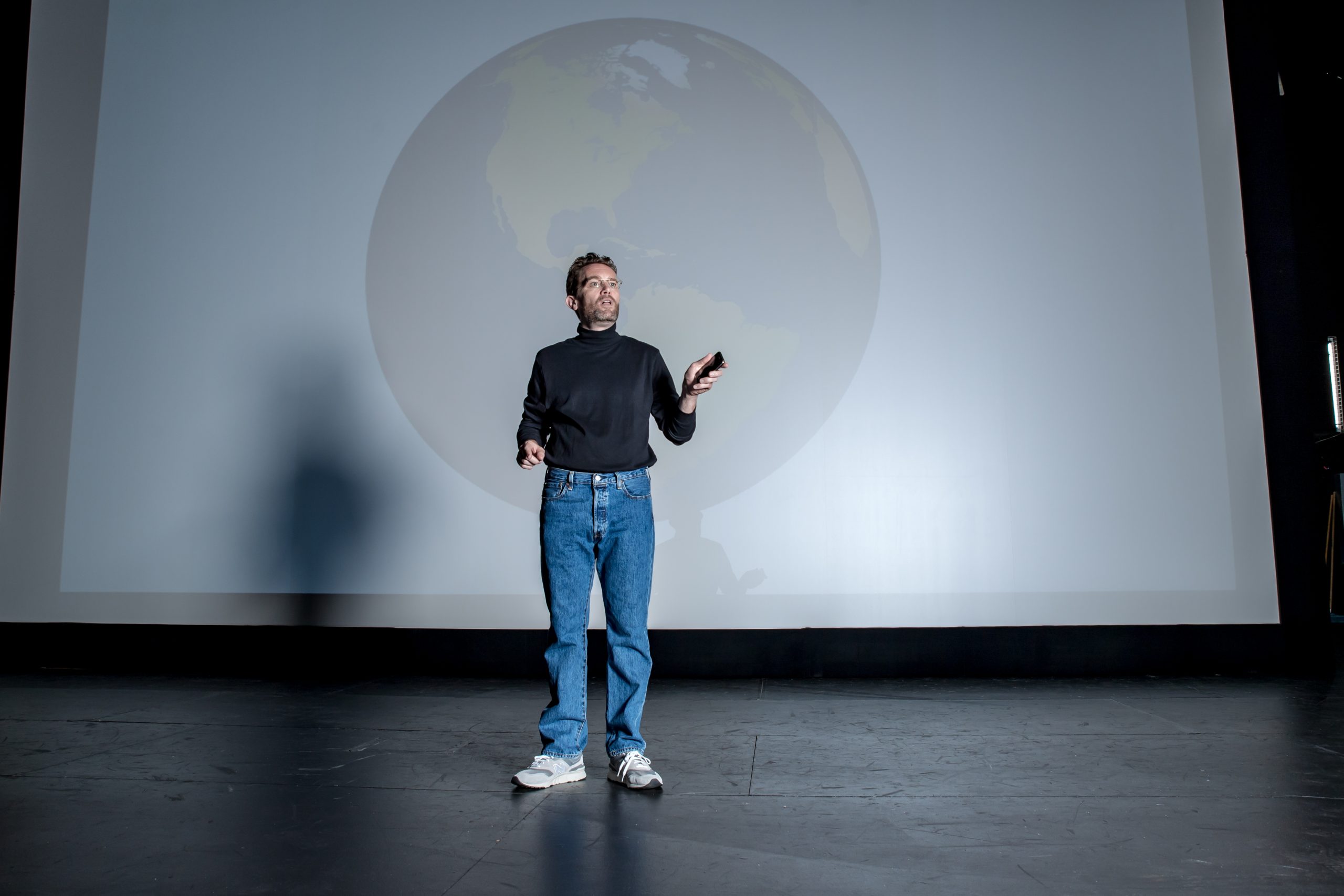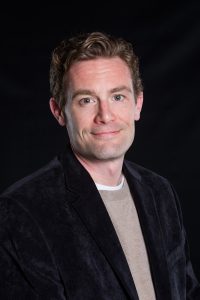
Event details
- June 14, 2023
- 3:00 pm - 4:30 pm
- 151 S Church St, Spartanburg, SC 29306
- 864-596-3500
 ASL interpreted Show
ASL interpreted Show
Registration required. Click here to register.
FREE Admission. Seating is limited.
Steve Jobs, portrayed by Jeremy Meier
“Think Different” was no grammatical error. The slogan was intended to inspire a mindset in the same way one might say “think big” or “eat smart.” Steve Jobs sought equal parts beauty, function, and simplicity of design. A zealous perfectionist, Jobs tested the boundaries of creative possibility and often the patience of his collaborators. But consider the impact Steve’s ambitious explorations have had in our lives – how we function, communicate, and are entertained. In the world of Steve Jobs, stasis would be challenged and excelsior a road map. Home computing, communications, music listening, and movie magic were all revolutionized along the way. Steve Jobs wanted to know what was next. He sought this answer for 35 years and fervently investigated possibilities.
Shows Schedule

Jeremy Meier serves as the Chair of Fine and Performing Arts at Owens Community College in Northwest Ohio. He has directed 19 student productions at the school, including Shakespeare’s Twelfth Night and Romeo and Juliet. Audiences last saw Jeremy in his portrayal of Robert F. Kennedy as part of Greenville Chautauqua’s Challenge: Accepted in 2022. In 2017, Meier was awarded a grant by Ohio Humanities to pilot the state’s first Chautauqua Training Program for new scholars learning to develop original performances based on historical figures.
The “See-cret” Jeremy Meier
“I’ll know it when I see it,” said Apple CEO Steve Jobs in 2010. Those seven words may be the answer. Perhaps the answer is five words Jobs said to Jony Ive during the creation of the iPod: “Create something very very new.”
Steve Jobs made computers accessible to the world. Then he made them fit in our pocket. The question— what was the secret to Steve Jobs’ vision?
Jobs wanted the computer to be “a bicycle for the mind.” To Jobs, computers could be a tool capable of bestowing an enhanced efficiency and an enhanced creativity to its users. This analogy sounds simple enough but making the complex workings of a computer sleek and user-friendly was no easy task.
The friendship and partnership between Steve Jobs and Steve Wozniak is well documented. “Woz” was a technical wizard; his contributions to 1970’s computing gave life to the Apple I and inspired possibilities for what a computer could do. Jobs was not a programmer but he recognized in Woz’s early experimentations the beginning of something “very very” big.
Author Malcolm Gladwell refers to Jobs not as a visionary but rather a “tweaker.” The distinction? “The visionary starts with a clean sheet of paper, and re-imagines the world. The tweaker inherits things as they are, and has to push and pull them toward some more nearly perfect solution. That is not a lesser task.” 1
In 2009, Fortune Magazine named Steve Jobs the CEO of the Decade. The accolade touted Apple’s transformation of the music industry as well as cell phone technology. Digital music players had already existed before Apple entered the forum. So, too, existed the cell phone and the Blackberry. What made Jobs’ contributions to these technologies profound? Apple made them better. Infinitely better. And Apple connected them into one device.
Shortly before this Decade of Jobs, Steve had returned to the company he and Wozniak had founded many years prior with a fervent approach to making new and better products. “I didn’t see it then but it turned out that getting fired from Apple was the best thing that could have ever happened to me. The heaviness of being successful was replaced by the lightness of being a beginner again, less sure about everything. It freed me to enter one of the most creative periods of my life.” 2
Among the first objectives in Jobs’ return to Apple was the company’s “Think Different” campaign. Apple would now be a company advertising its values. Consider the beginning of its 1997 commercial.
“Here’s to the crazy ones. The misfits. The rebels. The troublemakers. The round pegs in the square holes.
The ones who see things differently.” 3
As the Decade of Jobs began, millions of Americans were burning CD’s on personal computers. (The iMac did not have a cd burner.) Napster and other startups allowed consumers to pirate their music causing artists and producers to seethe. The introduction to the first iPod in 2001 offered users a compact device that allowed them to take their entire music collections with them on the go. (Download all your CD’s into this small device! It will hold your entire library!) That was not enough to satisfy Jobs’ estimation of the technology’s potential. Two years later, the iTunes Store was launched. Artists were paid for their music, a song at a time and consumer selected playlists were the new way of personalized listening. This was a new way of listening, consuming and selling music.
As for wireless devices— in Jobs’ words, “everyone hated their cell phone.” Remember the days of pressing on the plastic buttons of your cell phone repeatedly in order to select the next letter you needed to spell a word in a text message? And Blackberry devices forced users to handle a bulky plastic keyboard which made up a third of the device. Styluses were used for operations on so called “smart phones.” Styluses were also capable of hiding in a couch cushion or under a car seat. When Jobs unveiled the iPhone at the 2007 MacWorld conference he did so with a ringmaster’s flair. “This is a day I’ve been looking forward to for two-and-a-half years!” 4
A bulky plastic keyboard? There was not one to be found on this new technology. A stylus? Jobs boasted while wiggling fingers, “God gave us ten styluses.” Apple’s patented Multi-Touch technology allowed users to enlarge and minimize the image on the screen. Room for further improvements? Of course. The App Store was created the following year and allowed users to download new functions for their devices; it also cultivated further innovation by app creators.
“This is one device,” said Jobs. One device to be sure; capable of directing users to a destination while capturing images and sharing the journey with other humans along the way. This was a truly a bicycle for the mind.
Steve Jobs had a clarity of vision for what existed and the creative tenacity to pursue what was possible. The closing lines of the “Think Different” commercial provide a noteworthy coda to the secret of Jobs’ vision.
“The people who are crazy enough to think they can change the world are the ones who do.”
1 The New Yorker (November 14, 2011 issue)
2 from Steve Jobs’ Commencement address at Stanford in 2005
3 Apple’s 2001 “Think Different” ad campaign
4 from Steve Jobs’ keynote at the 2007 MacWorld
- 1969
- Meets and befriends another Steve (Wozniak). “Woz” is five years older but shares with Jobs an enthusiasm for electronics, practical jokes and music.
- 1973-74
- Enrolled for the fall semester at Reed College. Jobs drops out but audits classes he finds of interest in the spring term. Jobs does not return the following fall.
- 1974
- Goes to India on a pilgrimage of enlightenment.
- 1976
- Steve and Steve begin assembly of the Apple I in Jobs’ adoptive parents’ home and garage.
- May 17, 1978
- Chrisann Brennan gives birth to a daughter. Jobs later acknowledges he is the father.
- December, 1979
- Visiting Xerox PARC, Jobs sees a graphical user interface (GUI). It is the kind of breakthrough he has been looking for in order to make computers accessible for the masses.
- December, 1980
- Apple becomes a public entity. Jobs’ share of the company makes him one of the richest twenty-five-year-old’s in history ($256 Million).
- January 22, 1984
- Apple premiers a national Macintosh commercial during the third quarter of Superbowl XVIII. It promises a new product that will change the industry.
- September, 1985
- Resignation from Apple after bitter disagreements with CEO John Sculley.
- 1986 to 1996: Steve Jobs’ “Wilderness Period”
- Development of the NeXT Computer
- Meets his biological mother and meets his biological sister (novelist Mona Simpson)
- Meets and weds Laurene Powell
- Development of Pixar, collaboration on Toy Story with John Lasseter and others
- Apple buys the NeXT operating system for $400 Million.
- July, 1997
- Introduced as Apple’s interim CEO. Months later, Apple’s new “Think Different” campaign begins and signals a new direction for the company.
- October, 2001
- The iPod is unveiled. Two years later, the iTunes Store is introduced.
- January, 2007
- Introduces the iPhone via keynote address at the 2007 Macworld conference.
- January, 2010
- The iPad is released.
- August 24, 2011
- Battling cancer, he resigns as CEO of Apple. Steve Jobs dies on October 5.
Steve’s often quoted mantras:
“For the first thirty years, you make your habits. For the last thirty years of your life, your habits make you.” –from an old Hindu saying
“Stay hungry. Stay foolish.” –from the back page of the final issue of ‘The Whole Earth Catalog’
Steve’s philosophy:
“The people who are crazy enough to think they can change the world are the ones who do.”
“A lot of times, people don’t know what they want until you show it to them.”
“I’ll know it when I see it.”
“People do their best work when they do what they are best at.”
“You have to trust that the dots will somehow connect in your future. You have to trust in something—your gut, destiny, life, karma, whatever. This approach has never let me down, and it has made all the difference in my life.”
“When I was seventeen, I read a quote that went something like ‘If you live each day as if it was your last, someday you’ll most certainly be right.’ It made an impression on me.”
“Artists sign their work.”
“Picasso had a saying, ‘good artists copy, great artists steal.’”
“[Bob] Dylan and Picasso were always risking failure. That’s what made them artists.”
“I would trade all my technology for an afternoon with Socrates.”
Steve on technology:
“What a computer is to me is it’s the most remarkable tool that we’ve every come up with, and it’s the equivalent of a bicycle for our minds.”
“God gave us ten styluses. Let’s not invent another.”
“I used to say that Apple should be the Sony of this business, but in reality, I think Apple should be the Apple of this business.”
“Simplicity is the ultimate sophistication.”
On the man:
Steve Jobs by Walter Isaacson (2011) This is the big one, 577 pages in length. (The audiobook is long enough to accompany you most of the cross-county drive from Greenville to Palo Alto, California.) This book offers a look at Jobs from many angles—his reputation as a harsh perfectionist is illustrated alongside a portrait of an imaginative genius. Jobs encouraged Isaacson to interview friends and colleagues as well as former friends and past colleagues. Said Jobs, “I don’t have any skeletons in my closet that can’t be allowed out.”*
Steve Jobs: The Man Who Thought Different by Karen Blumenthal (2012) An unauthorized biography, it is an interesting read while dispensing with intimidating length. (Consider it a Greenville-to-Nashville length audiobook.) Blumenthal tells Jobs’ life story in three parts, framed within lessons he shared at a 2005 commencement address at Stanford University.*
Small Fry: A Memoir by Lisa Brennan-Jobs (2018) One key participant whom Walter Isaacson did not have the opportunity to speak with was Job’s daughter, Lisa. This memoir is a perspective on her father, the man who introduced the world to another “Lisa” (Apple’s computing system in 1983) and who was periodically connected and disconnected from her life.*
Becoming Steve Jobs by Rick Tetzeli and Brent Schlender (2015) In his role as reporter, Brent Schlender knew Jobs for over two decades. Their conversations over the years shaped an impression that curtails much of the harsh reputation as described in other biographies. This book focuses on Jobs’ creative evolution, particularly during this “Wilderness Period” between the dismissal from Apple in 1985 and return in 1997.*
On the technology:
Revolution in the Valley: The Insanely Great Story of How the Mac Was Made by Andy Hertzfeld (2005) A key member of the team which “built the Mac,” Hertzfeld offers a firsthand perspective on how a user-friendly personal home computer came to be. Illustrations, drawings and a collection of photographs enhance the reader’s experience.
To Pixar and Beyond: My Unlikely Journey with Steve Jobs to Make Entertainment History by Lawrence Levy (2016) Steve Jobs did not know the potential of computer animation as an artform when he purchased a computer division from George Lucas in 1986. The result was a company soon-to-be-known as Pixar. This book discusses the tensions, creativity and transformation of an artform in which Jobs played a pivotal role.*
For young readers:
Who Was Steve Jobs? by Pam Pollack and Meg Belviso (2012) This short biography is an accessible account of Jobs’ life and times. It bridges the gap for today’s youth to a time in which computers and computing was in a whole different era of comprehension.*
*Available in the Greenville County Library System
